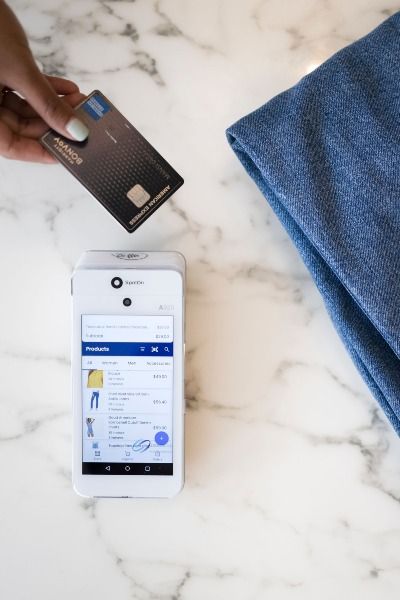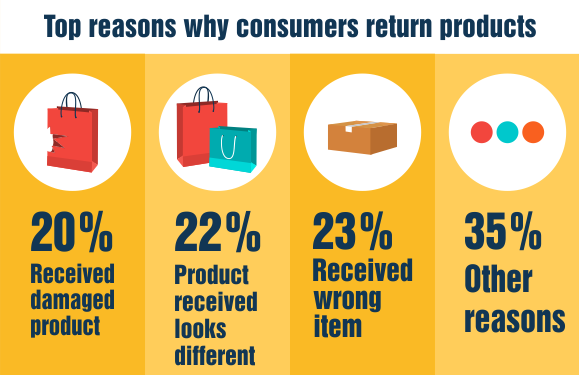The product return process can be full of ambiguity that slows things down. You need to find out if products are in good condition to be returned, and you might need to arrange pickups. It’s especially hard when you manage remote teams, and nobody can just lean over from behind their monitor to ask a question.
But with some optimization, you can create and turn your store return policy into something to be proud of: a real asset to your business that increases productivity and revenue and creates a great customer experience.
What is a store return policy?
A store return policy or product return process is different for every company and product. But in most cases, follows these five basic steps:
- The customer receives a product and, at some point, decides they’re unhappy with it and asks for a refund and/or return.
- The company evaluates the claim, and either approves or disapproves the return. In some cases, they’ll offer a refund or exchange for another product.
- The company receives the product, either picking it up or having the customer send it back.
- The product is received at the warehouse or store and inspected.
- If the product is in good condition, it’s put back into stock, and the customer is refunded.
Within this basic framework, however, there’s lots of room for optimization specific to your company. Let's explore how to write a return policy and eight ways to optimize your return policy to save money and enhance your customer experience.
1. Make your store return policy clear
The quickest way to optimize your product return process, whether in-store or online, is to make your return policy as clear as possible. This is for the benefit of both your customers and your staff.
Ideally, customers shouldn’t have to ask whether or not something is eligible for return. If they do, staff should have a very clear flowchart on hand to consult. Your customer support agents are already busy, so your product return process should remove unnecessary conversations and streamline the ones that do occur.
Your product return process should be so good it’s a selling point. Highlight it across landing pages, product pages, and your online checkout, and you’ll avoid the effects of shopping cart abandonment.
Shopping cart abandonment can be frustrating if you’ve done everything right—conduct extensive user research, A/B test the life out of it, embed Instagram feed for social proof—and if you can’t reach those lost customers with email or retargeting, they’re likely gone.
66% of customers said they’d spend more with a generous return policy, and this willingness to spend is a big factor in your cart abandonment rate.
When creating your store return policy, be sure to clearly state the following:
- How many days or weeks customers have to make returns after delivery
- What conditions need to be met to be eligible for a return
- What exceptions there are to those conditions
- The different options customers have for receiving payment
- How long customers should expect payment to take
No doubt, there are opportunities for micro-optimizations specific to your company we can’t address here. Speak to the team members who deal with returns and see what ideas you can develop together. If you find that returns are due to complaints about shipping, consider adding dunnage into certain packages to save you time and money handling returns.
2. Remove the need for receipts from your return policy
Whether or not you can take in-store returns without a receipt may be affected by local consumer rights laws. It’s excellent customer service wherever you can make it work. Many people assume a receipt is necessary to return something in-store, so it always feels like the company is going above and beyond for them when they don’t require one.
You can make this feasible for your business with an all-in-one point of sale (POS) system that makes it easy for retail staff to locate orders. That could mean locating the purchase using the product serial number or simply asking the customer for their email or phone number.
If you have that information already, you can easily locate proof of purchase in the system. Don’t miss the opportunity to onboard the customer into your marketing SMS and email flows if they’re not signed up already. With the promise of benefits like exclusive discount codes, you can use this moment to deliver even more value to the customer.

3. Use gift cards
One problem companies and employees have with their product return process is making sure they’re not handing out money when they shouldn’t be. Providing refunds via gift cards or store credit can optimize this process because it removes some uncertainty: whether or not the customer spends that gift card, you’re keeping the money.
This also improves the customer experience because it allows in-store staff to make “refunds” on the spot, even if they’re having trouble finding the order in their system. If the gift card doesn’t incentivize the customer to spend with you again, it might be a marketing opportunity: they could pass that on to someone else who’ll become a new customer and make up for any lost business.
4. Track the reasons for returns
Returns are inevitable, and they don’t necessarily reflect poorly on your business. Nevertheless, you can get more value from your product return process by carefully tracking the reasons for returns.
If you’re selling clothes, you might discover that sizing is a persistent issue. If you’re selling an appliance like a stovetop coffee pot, you might find it’s worth including a replacement for the cheap rubber gasket that buckles after a year of heavy usage.

5. Streamline deliveries and collections
If you’re sending out couriers to deliver your products, your store return policy might be subject to the same last-mile delivery headache that logistics companies like Amazon have to deal with every day.
Sending a courier to deliver your product eats into your profit margin, but when you send them just to pick up a return, there’s no profit at all. By keeping an eye on your deliveries with software like OptimoRoute, you can respond to returns on very short notice if you already have a courier nearby.
Hardie’s Fresh Foods, for example, saved 20% on travel just by catching returns this way. They also managed to increase their delivery capacity by 14% without adding a single new driver or vehicle.
6. Plan ahead
Planning ahead can help you manage variable demand for deliveries and returns without having to stretch to hire new vehicles or temporary staff. Smoothing out the stress put on your operations can have benefits in other parts of the company. It’s good for morale if teams aren’t running around trying to keep up with the business.
Times like the holiday seasons are an opportunity for high velocity sales, but this blessing can be a curse if your sales and logistics processes aren’t automated. Mistakes can easily be made. This would create more problems in the returns process, which is already a critical time for keeping customers engaged.
7. Prioritize the customer experience
The “recovery paradox” is a well-documented phenomenon in customer service. If a company makes a mistake and recovers well—say, your product had to be returned, but you were very helpful—the customer will think more highly of you than if you’d performed flawlessly.
By making your product return process a great customer experience, you can take advantage of the recovery paradox at a critical time. If the process is slow or frustrating, customers might not return.
As standard, you could take the time to get to know these customers personally and understand why they’re returning the product. This is valuable data, especially for a growing company.
But you can also look for opportunities to improve the process on a case-by-case basis. For smaller items, Amazon offers “no-return refunds” where it wouldn’t be worth the time or effort to ship and receive the product. This is a win-win-win situation where the customer is refunded, the seller keeps their money from the original purchase, and Amazon saves money.
Think about adding a personal touch to the product return process where you can. Apple, for example, uses custom mailer boxes for returns and repairs for postal deliveries. This ensures the customer has a premium, branded experience even if they can’t make it into an Apple Store.
8. Invest in software and hardware
Anyone with distant memories of working in retail reads “checkout” or “point-of-sale system” and thinks of clunky machines with slow, aging software. But retail has changed, and the new generation of POS system is keeping up. If you’re running an in-store product return program, you need hardware that talks to every part of your business in real time and enables better customer experiences.
An up-to-date POS solution gives your staff real-time data with which to make decisions about returns, whether that’s offering a suitable product exchange then and there or arranging a home delivery.
The benefits of an optimized product return process
A product return system sounds like a back-room necessity, just a process that needs to exist but doesn’t drive much value. But by optimizing the process with better technology and putting the customer experience first, you can take advantage of the recovery paradox and win more customer loyalty in the long term.













